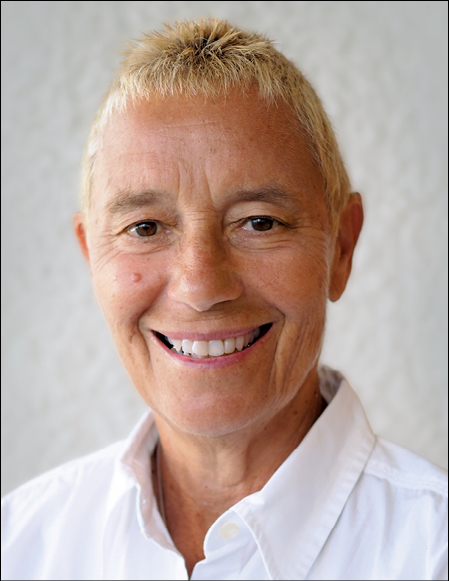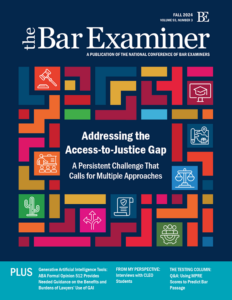This article originally appeared in The Bar Examiner print edition, Summer 2022 (Vol. 91, No. 2), pp. 1–2. By Suzanne K. Richards
 In the past year, I have had the pleasure of attending meetings with various members of the bar admissions community: with justices of jurisdictions’ highest courts, bar admission administrators, bar examiners, and representatives of entities such as AccessLex, the American Association of Law Schools, and the Law School Admission Council. Each has different missions and plays different roles in the bar admissions world. These distinct missions and roles necessarily shape their perspectives on the many issues facing bar admissions today. But more important and more striking than their differences is that all are dedicated to the advancement and improvement of the legal profession. All deeply care about the profession’s role in upholding our society’s basic values.
In the past year, I have had the pleasure of attending meetings with various members of the bar admissions community: with justices of jurisdictions’ highest courts, bar admission administrators, bar examiners, and representatives of entities such as AccessLex, the American Association of Law Schools, and the Law School Admission Council. Each has different missions and plays different roles in the bar admissions world. These distinct missions and roles necessarily shape their perspectives on the many issues facing bar admissions today. But more important and more striking than their differences is that all are dedicated to the advancement and improvement of the legal profession. All deeply care about the profession’s role in upholding our society’s basic values.
As I complete my year as chair of the NCBE Board of Trustees, I have been thinking more about the concept of “community” as used in the phrase “bar admissions community.” As one pundit aptly observed, the foundation of a community is the common unity of its members. Members of our community may have differing views, but they remain committed to common, overarching goals. This unity is based, in part, on shared values. It demands undertakings with one another based upon honesty and integrity; it rests upon being inclusive, not exclusive; and it asks that we discuss and debate and disagree through civil discourse, not harsh and condemning critiques. Serious issues confront the legal profession—and thus admission to it—today, but our community must continue to engage one another civilly, understanding that we all ultimately seek the same end: a profession that exemplifies integrity, competency, and diversity.
Differences of opinion on issues and how best to address them do, of course, exist. Indeed, at times there are significant disagreements. The question of the impact of the bar examination on certain racial groups, especially on Black applicants, has been the subject of much writing and discussion. In concluding that the exam is discriminatory, many such articles begin (and often end) with the oft-cited statistic that in 2020 88% of first-time White takers passed, whereas the percentage for first-time Black takers was 66%.1 Without more information, this difference states a correlation; it does not establish a causal relationship.
Any high-stakes licensing exam, whether it be for lawyers, doctors, accountants, or other professionals, is best constructed in accordance with the Standards for Educational and Psychological Testing. The Standards, as modified over time, provide best practices for constructing such exams; importantly, they include standards for fairness. (See the article in this issue about Standards and its foundational concepts, including fairness.) The Standards explicitly note that they do not address “fairness” in terms of the “equality of testing outcomes for relevant test taker groups.”2 However, they do address fairness in constructing test items so as to not unfairly impact any racial group. Moreover, the Standards note that “group differences in outcomes do not in themselves indicate that a testing application is biased or unfair.”3
Judged by the best testing practices and supported by psychometric analyses, it is possible to construct a fair high-stakes licensing exam. That being so, simply to refer to a statistical difference in outcomes as grounds for discarding objective, standardized testing seems to me misguided; thus, I argue here for a more nuanced approach to this very complex problem. Only citing statistics ignores the complete picture. It disregards, for example, that while we are generalizing about racial groups, these groups are not homogeneous.
It is noteworthy that the ABA report from which the bar passage data is obtained states that “the reported information does not depict differences in bar passage rates based on any other background variables.”4 Research indicates that similarly credentialed applicants, regardless of race, generally have similar passage rates. Moreover, in focusing on outcomes alone, such an analysis ignores the very real differences among racial groups in this country: Blacks as a group have generally not been afforded the same opportunities as Whites as a group. There are—again speaking generally—large differences in family income and other resources and, likewise, differences in school quality and other educational opportunities. Because of limited means, many have to work during law school and during the study period prior to the bar exam, thus limiting the time they have to study. It might also mean difficulty in buying high-quality bar preparation materials.
These socioeconomic factors cannot be remedied overnight, but perhaps the development and expansion of programs geared to provide financial and other support both during law school, and more immediately, during the study period before the exam, can make them less of a factor in determining exam outcomes. Such programs have already been initiated by individual law schools, the Council on Legal Education Opportunity, NCBE,5 AccessLex, and others, but the results are still preliminary and further development and expansion is needed to see whether they will help to lessen or eliminate different outcomes among racial groups.
And such programs need not be the only answer. There may be other creative and innovative approaches. What is important is that we recognize the problem is complex and requires a commensurate response. What is important is that we as a community continue working together to address the issue. I truly believe our efforts will succeed, for, to borrow a thought an historian once expressed: it is impossible that we will always be right, but unlikely we will always be wrong.
Best regards to all,

Suzanne K. Richards
Notes
- American Bar Association, Legal Education and Admissions to the Bar, “Summary Bar Pass Data: Race, Ethnicity, and Gender, 2021 and 2022 Bar Passage Questionnaire,” https://www.americanbar.org/content/dam/aba/administrative/legal_education_and_admissions_to_the_bar/statistics/2022/2022-bpq-national-summary-data-race-ethnicity-gender-fin.pdf. (Go back)
- American Educational Research Association (AERA), American Psychological Association, and National Council on Measurement in Education, Standards for Educational and Psychological Testing (AERA, 2014), p. 54. (Go back)
- Id., p. 54. (Go back)
- Supra note 1. (Go back)
- For instance, NCBE’s partnership with the Council on Legal Education Opportunity (CLEO) to form the NCBE/CLEO Bar Passage Program, which is designed to help CLEO students prepare to pass the bar exam. See Cassandra Sneed Ogden and Lynda Cevallos, Esq., “Focus on Diversity: Great Lawyers—Becoming and Belonging: The NCBE/CLEO Partnership Prepares Students to Climb the Mountain,” 90(1) The Bar Examiner (Spring 2021) 69–72. (Go back)
Contact us to request a pdf file of the original article as it appeared in the print edition.







